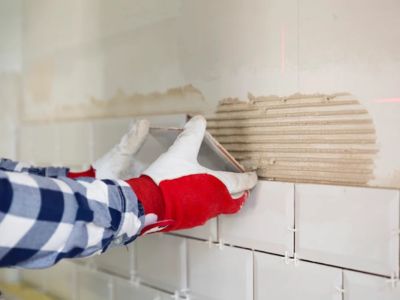
Subway tiles originated from the United States and made their way across the globe, especially the United Kingdom. Subway Tiles also known as Metro Tiles are a unique type of tiles that almost everyone knows. These tiles were created by the designers to make dark places brighter and appear clean.
These tiles were introduced by the designers of subway tunnels/metro tunnels. These tiles carry a sense of historical importance and are relatively simple-looking yet attractive. These became popular for designers in the modern market as they blended with certain environments effortlessly such as bathrooms and kitchens.
The History Of Subway Tiles

Subway tile history dates back to the 20th century. It was introduced by the designers of subway/metro tunnels in New York, USA. Ever since the introduction of subway tile/Metro tiles, they have never fallen out of the trend because of the simple and compact nature of the tile. These tiles are available in various shapes and sizes; such as rectangles, squares, running bonds, herringbone, etc. Due to such availability, these tiles prove to be one of the most perfect sets for bathrooms and kitchens where there is significantly more activity.
A common question that may arise is what are these tiles made up of? Subway tiles are available in both ceramic and porcelain materials. But Subway porcelain tiles are harder, and more durable than ceramic tiles and also offer more versatility. Glass and marble finish subway tiles are also available but are expensive and require a bit more maintenance.
All these features make porcelain subway tiles a good choice for bathrooms and kitchens. Aesthetically we can justify this choice by analysing the simple nature of the tile. You can also use white metro tiles / subway tiles that make the environment a bit brighter and cleaner, something that is rather important in bathrooms and kitchens.
How Are Subway Tiles Made?

Subway tiles are commonly manufactured from materials like ceramic or porcelain. However, alternatives like glass and natural stone are also available. Each material possesses distinct attributes, encompassing aesthetics, resilience, and maintenance prerequisites. Consequently, when selecting subway tiles for your project, it is crucial to factor in the spatial requisites, your design inclinations, and your tolerance for maintenance.
It's worth noting that the choice of subway tile material can be influenced by various factors, including personal preferences, budget constraints, and the specific requirements of the space in which they will be installed.
Importance of Subway Tiles
Subway tiles were introduced in society because of their clean and neat look. Another peculiarity that made it famous was its colour availability such as white, blue, black, brown and many more. These features provide uniqueness and enhance the environment. In the modern market, homeowners are inclined towards something simple, compact, and durable. These requirements are met by porcelain subways tiles for the bathroom and kitchen.
There are several other material tiles available in the market, but we recommend porcelain when it comes to surfaces that are prone to high usability and durability. Over the years subway tiles have stayed persistent in the market and their usability has constantly grown over time. With reforms in technologies and production, these tiles became popular in residential and commercial spaces because of their features.
Installation Of Subway Tiles

Installation is an important aspect of decor as it has many pressure points throughout the process. The overall appearance of space depends on perfect installation. Let's have a discussion on the right installation steps for subway tiles.
Step 1: Prepare the Surface
Ensure that the surface where you will install the subway tiles is prepared for installation. You need to clean, dry, and make it free from debris or grease. If necessary, repair any cracks or imperfections in the wall surface and allow them to dry completely.
Step 2: Measure and Plan
Measure the area where you will be installing the tiles and plan the layout to determine the best starting point and ensure even spacing of the tiles. Use tile spacers if necessary to maintain consistent spacing between tiles.
Step 3: Prepare the Tiles
If the subway tiles need to be cut to fit around edges or obstacles then use a tile cutter or wet saw to make precise cuts. When cutting the tiles ensure to wear appropriate safety gear such as safety glasses and gloves. Follow the manufacturer's installation guide and manual thoroughly for strategic installation of subway tiles.
Step 4: Mix Thinset Mortar
Mix thinset mortar according to the manufacturer's instructions until it reaches a smooth. Ensure it has a perfect mix and acquire an appropriate spreadable consistency. Use a trowel to apply a thin layer of mortar to a small section of the wall. You can start at the bottom and work your way up.
Step 5: Apply Tiles
Press the subway tiles firmly into the mortar in the desired pattern. You can use tile spacers to maintain even spacing between tiles. Work in small sections to ensure that the mortar does not dry out before the tiles are installed.
Step 6: Cut and Fit Tiles
As you reach the edges of the wall or obstacles such as outlets or switches to measure and cut tiles to fit using a tile cutter or wet saw. Ensure that the cut edges are smooth and fit snugly against adjacent tiles.
Step 7: Allow Mortar to Set
Allow the mortar to set for the time specified by the manufacturer. It takes typically 24-48 hours before grouting the tiles. Avoid disturbing or applying pressure to the tiles during this time.
Step 8: Grout the Tiles
Once the mortar has set, mix grout and apply it to the spaces between the tiles using a grout float. Work the grout into the joints at a 45-degree angle. During this procedure make sure that all spaces are filled. Otherwise it can ruin the aesthetics of tiles.
Step 9: Clean Excess Grout
After applying the grout, use a damp sponge to wipe away any excess grout from the surface of the tiles before it dries. Rinse the sponge frequently in clean water to avoid smearing grout over the tiles.
Step 10: Finish and Seal
Once the grout has dried completely, typically after 24-72 hours, use a clean, dry cloth to buff away any haze left on the tiles. Finally, apply a grout sealer to protect the grout and tiles from moisture and stains.
Over To You
Today, Subway tiles are used for bathroom and kitchen areas because of their simple and compact nature while being resistant to a majority of wear and tear. Along with durability, it also excels in looks. Subway tile is available in various colours, styles, sizes and finishes. The above-mentioned features of subway tiles make them an ideal fit for kitchen and bathroom areas and the same reason is why these tiles never left the trend in the market.
FAQs
What are subway tiles?
Subway tiles are rectangular ceramic or porcelain tiles commonly used for wall coverings, backsplashes, and bathroom surfaces.
Why is it called subway tile?
Subway tiles earned their name from their historical association with New York City's subway system, where they were first used in the early 20th century.
Common subway tile sizes?
Subway tiles typically come in standard sizes, with the most common being 3 inches by 6 inches. However, other sizes like 2 inches by 4 inches and 4 inches by 8 inches are also available, offering flexibility in design.
What are the types of subway tiles available?
Subway tiles come in various materials, including ceramic, porcelain, glass, and natural stone. They also offer different finishes, such as glossy, matte, or textured, catering to diverse aesthetic preferences.
Is subway tile expensive?
The cost of subway tiles can vary depending on factors like material, brand, and quality. In general, ceramic subway tiles tend to be more affordable, while options like glass or natural stone can be pricier.



















